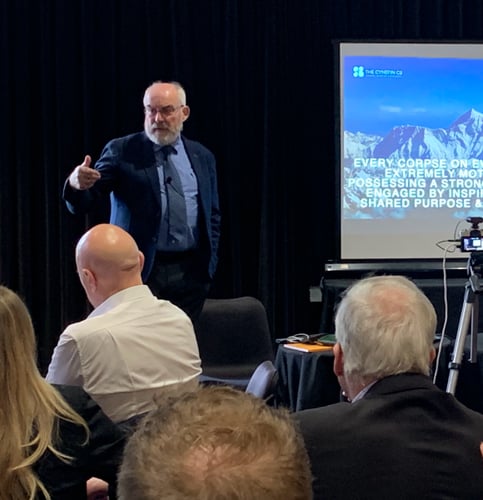
Many of our clients find that their risk management processes struggle to accommodate the uncertainty in the strategic environment. Additionally, they understand that innovation is vital to their ability to survive and thrive in this uncertainty.
Recently, at a conference titled ‘Risk and Resilience,’ I gave a talk on resilience. I started with the question: What is resilience?
It turns out that not many people could answer the question. This was surprising, given that several speakers had used resilience as the basis for their presentations.
I want to outline a valuable approach to risk and resilience based on an organization’s adaptive capacity.
Resilience
One of the challenges we see is people confusing resilience with robustness. There is a big difference between resilient systems and robust systems.
Robust systems resist change without adapting their stable configuration. In practice, we create systems that can withstand the forces of change or avoid them. Success depends upon our ability to predict and plan for the changing environment. Failure should be avoided, and recovery is costly.
Robustness is a good idea when the system needs to function consistently for a long time or when small failures may have catastrophic consequences. Nuclear power plants are a good example. Large infrastructure projects and utility companies are less dramatic examples.
Robustness is a mechanical metaphor: Your organization is a machine. This idea has dominated the last 75 years of strategy and risk management.
Resilience is the amount of disturbance that a system can sustain or absorb without changing its structure, essence, function, and identity. In practice, maintaining a capacity for renewal in a dynamic environment provides a buffer that protects the system from failure. We can take actions based upon incomplete understanding, allowing us to affordably learn and change.
Resilience is a good idea when you are faced with constant change and uncertainty. Creating a system that responds positively to change is an advantage.
Resilience is an ecological metaphor: Your organization is part of an ecosystem. This is the paradigm to embrace uncertainty and turn it into a strategic advantage.
Risk management has a problem
Robust systems lack resilience. Many organizations want to create resilient systems but inadvertently create robust (or brittle) systems. A good example is the robust solutions provided by just-in-time supply chains. These systems will optimize the organization for efficiency and cost, but recent experience has shown that small things can create massive failures. One ship stuck in the Suez Canal created a cascading effect on a system that lacked resilience.
Being resilient involves two distinct aspects: creating adaptive capacity and the manifestation of that capacity.
Adaptive capacity
Many utility companies understand that they will be overwhelmed by social, climate, and economic change unless they innovate. Years of traditional asset management planning have created a robust approach to investment and resource allocation. We have worked with many of them to shift from a purely robust approach to creating more adaptive capacity.
The AGLX adaptive strategy process provides the platform for adaptive capacity. It privileges action over analysis and makes exploration a critical aspect of success. Organizations that activate an adaptive strategy shift their focus from an uncertain future to a certain present. The activation process can be summarised in the question, “How can we maximize our current potential?”. This statement is aligned with how natural systems operate. Each organism seeks to maximize its potential within the ecosystem. The ecosystem is continuously dynamic, creating the conditions for continuous evolution. Organisms that cannot evolve to meet the changing demands of the ecosystem quickly become extinct.
In strategy, traditional methods like Porter's Five Forces method teach us to seek to create a structural advantage and defend it via barriers to entry such as contractual relationships, intellectual property protection, and economies of scale.
These organizations are robust; they may tolerate or avoid change for a while, but the reality of the dynamic strategic environment will inevitably render them obsolete. The AGLX ICE Innovation® process is designed for organizations that have already adopted a strategy that makes them robust. Robust systems work for organizations like utilities and others, making long-term investments in infrastructure. ICE innovation® provides the framework for maintaining curiosity in the face of a desire to solve problems through analysis and execution.
Organizations should use innovation and exploration to develop a more cohesive network. Small, diverse teams that form around ideas to rapidly test and learn provide the basis for informal solid networks. The secondary benefits of this will be increased engagement, better communication, and less siloed activity.
Manifestation of adaptive capacity
Manifestation is the ability to act when faced with uncertainty or sudden change. Business, as usual, typically focuses on the things that create value; we have rules and processes that make repeatability and manage risk – a robust approach. We are all familiar with good ideas being extinguished by a lousy process. In most organizations, this involves lost opportunity. We need to be able to act quickly and redistribute resources to meet emerging challenges. Things that inhibit adaptive capacity are the budget process, permission seeking, and command and control decision-making.
Every organization is different; therefore, the manifestation of adaptive capacity will be different. A one-size-fits-all or template approach to creating resilience will be unlikely to succeed. We need to practice adaptation and be sensitive to the constraints that emerge. Again, ICE Innovation® is an excellent framework to adopt. The role of leaders is to manage these constraints and allow people to explore, learn, and adapt. This is a change in the mode of operation; we lower the energy needed to explore, learn, and amplify the things that create value.
Overall, adaptive approaches to strategy and innovation create resilience. Resilience in the face of uncertainty and change is risk management. Systemic risk is reduced as we interact with the system to find new ways to create value. Traditional approaches force us to pick a strategy that we hope will be robust enough to withstand change.
To develop and manifest adaptive capacity in your organization, contact the AGLX team today to discuss your situation.
Illustration by Meg Cummins (AGLX)




